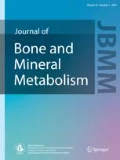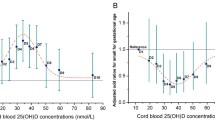Abstract
Skull changes are poorly described in vitamin D insufficiency [serum 25-hydroxyvitamin D (s-25(OH)D) 25–50 nmol/L]. We aimed to investigate factors associated with cranial anthropometrics in infants, especially s-25(OH)D. In infants 2.5–6 months old from the Odense Child Cohort, associations between cord and pregnancy s-25(OH)D and anterior fontanel area (n = 765), head circumference (HC, n = 1776) and head shape (n = 1527) were investigated along with other factors. Age was corrected for preterm birth. The mean (SD) s-25(OH)D in early pregnancy was 65.97 (21.33) nmol/L; late pregnancy 78.61 (27.18) nmol/L; and cord 47.1 (21.7) nmol/L. At median (IQR) age 3.7 (2.5–5.9) months, the fontanel area was 225 (0–1690) mm2, and mean (SD) HC was 41.5 (1.5) cm. Asymmetric/flat head shape was present in 846 infants (55.3%). No associations were found between cord, early or late pregnancy s-25(OH)D and any cranial measure by univariate or adjusted analysis. Among significant, independent associations in multivariate analysis, fontanel area was associated inversely with gestational age (GA); HC was associated directly with GA, maternal pre-pregnancy overweight and caesarean section and inversely with smoking; and asymmetrical head shape showed a novel association with male sex: adjusted OR = 1.54 (95% CI 1.25; 1.89), p < 0.001. Other associations with asymmetrical head shape included parity 3+, gestational age and maternal age 30+ years (all protective). In conclusion, neither pregnancy nor cord s-25(OH)D was associated with fontanel size, HC or asymmetrical head shape despite a high prevalence of cord s-25(OH)D < 50 nmol/L. Lower GA was associated with larger fontanel size, lower HC and asymmetrical head shape, and boys more frequently had asymmetrical head shape, probably due to heavier heads.
Similar content being viewed by others
References
Munns CF, Shaw N, Kiely M, Specker BL, Thacher TD et al (2016) Global consensus recommendations on prevention and management of nutritional rickets. J Clin Endocrinol Metab 101:394–415
Andersen L, Abrahamsen B, Dalgard C, Kyhl H, Beck-Nielsen S, Frost-Nielsen M, Jorgensen J, Barington T, Christesen H (2013) Parity and tanned white skin as novel predictors of vitamin D status in early pregnancy: a population-based cohort study. Clin Endocrinol (Oxf) 79:333–341
Lykkedegn S, Beck-Nielsen SS, Sorensen GL, Andersen LB, Fruekilde PB, Nielsen J, Kyhl HB, Joergensen JS, Husby S, Christesen HT (2016) Vitamin D supplementation, cord 25-hydroxyvitamin D and birth weight: Findings from the Odense Child Cohort. Clin Nutr. https://doi.org/10.1016/j.clnu.2016.10.008
Christesen HT, Elvander C, Lamont RF, Jorgensen JS (2012) The impact of vitamin D in pregnancy on extraskeletal health in children: a systematic review. Acta Obstet Gynecol Scand 91:1368–1380
Maiya S, Sullivan I, Allgrove J, Yates R, Malone M, Brain C, Archer N, Mok Q, Daubeney P, Tulloh R, Burch M (2008) Hypocalcaemia and vitamin D deficiency: an important, but preventable, cause of life-threatening infant heart failure. Heart 94:581–584
Price DI, Stanford LC Jr, Braden DS, Ebeid MR, Smith JC (2003) Hypocalcemic rickets: an unusual cause of dilated cardiomyopathy. Pediatr Cardiol 24:510–512
Pettifor JM, Prentice A (2011) The role of vitamin D in paediatric bone health. Best Pract Res Clin Endocrinol Metab 25:573–584
Beck-Nielsen SS, Jensen TK, Gram J, Brixen K, Brock-Jacobsen B (2009) Nutritional rickets in Denmark: a retrospective review of children’s medical records from 1985 to 2005. Eur J Pediatr 168:941–949
Tiosano D, Hochberg Z (2009) Hypophosphatemia: the common denominator of all rickets. J Bone Miner Metab 27:392–401
Kalra P, Das V, Agarwal A, Kumar M, Ramesh V, Bhatia E, Gupta S, Singh S, Saxena P, Bhatia V (2012) Effect of vitamin D supplementation during pregnancy on neonatal mineral homeostasis and anthropometry of the newborn and infant. Br J Nutr 108:1052–1058
Hutchison BL, Hutchison LA, Thompson JM, Mitchell EA (2004) Plagiocephaly and brachycephaly in the first two years of life: a prospective cohort study. Pediatrics 114:970–980
van Vlimmeren LA, van der Graaf Y, Boere-Boonekamp MM, L’Hoir MP, Helders PJ, Engelbert RH (2007) Risk factors for deformational plagiocephaly at birth and at 7 weeks of age: a prospective cohort study. Pediatrics 119:e408–e418
Bialocerkowski AE, Vladusic SL, Wei Ng C (2008) Prevalence, risk factors, and natural history of positional plagiocephaly: a systematic review. Dev Med Child Neurol 50:577–586
Kiely M, O’Donovan SM, Kenny LC, Hourihane JO, Irvine AD, Murray DM (2017) Vitamin D metabolite concentrations in umbilical cord blood serum and associations with clinical characteristics in a large prospective mother-infant cohort in Ireland. J Steroid Biochem Mol Biol 167:162–168
Rodriguez A, Garcia-Esteban R, Basterretxea M, Lertxundi A, Rodriguez-Bernal C, Iniguez C, Rodriguez-Dehli C, Tardon A, Espada M, Sunyer J, Morales E (2015) Associations of maternal circulating 25-hydroxyvitamin D3 concentration with pregnancy and birth outcomes. BJOG 122:1695–1704
Miliku K, Vinkhuyzen A, Blanken LM, McGrath JJ, Eyles DW, Burne TH, Hofman A, Tiemeier H, Steegers EA, Gaillard R, Jaddoe VW (2016) Maternal vitamin D concentrations during pregnancy, fetal growth patterns, and risks of adverse birth outcomes. Am J Clin Nutr 103:1514–1522
Kovacs CS (2014) Bone development and mineral homeostasis in the fetus and neonate: roles of the calciotropic and phosphotropic hormones. Physiol Rev 94:1143–1218
Kyhl HB, Jensen TK, Barington T, Buhl S, Norberg LA, Jørgensen JS, Jensen DFG, Christesen HT, Lamont RF, Husby S (2015) The odense child cohort: aims, design, and cohort profile. Paediatr Perinat Epidemiol 29:250–258
Tinggaard J, Aksglaede L, Sorensen K, Mouritsen A, Wohlfahrt-Veje C, Hagen CP, Mieritz MG, Jorgensen N, Wolthers OD, Heuck C, Petersen JH, Main KM, Juul A (2014) The 2014 Danish references from birth to 20 years for height, weight and body mass index. Acta Paediatr 103:214–224
Cole TJ (1990) The LMS method for constructing normalized growth standards. Eur J Clin Nutr 44:45–60
Petscher Y, Logan JA (2014) Quantile regression in the study of developmental sciences. Child Dev 85:861–881
von Elm E, Altman DG, Egger M, Pocock SJ, Gotzsche PC, Vandenbroucke JP (2008) The strengthening the reporting of observational studies in epidemiology (STROBE) statement: guidelines for reporting observational studies. J Clin Epidemiol 61:344–349
Brooke OG, Brown IR, Bone CD, Carter ND, Cleeve HJ, Maxwell JD, Robinson VP, Winder SM (1980) Vitamin D supplements in pregnant Asian women: effects on calcium status and fetal growth. Br Med J. 15:751–754
Faix RG (1982) Fontanelle size in black and white term newborn infants. J Pediatr 100:304–306
Gernand AD, Klebanoff MA, Simhan HN, Bodnar LM (2015) Maternal vitamin D status, prolonged labor, cesarean delivery and instrumental delivery in an era with a low cesarean rate. J Perinatol 35:23–28
Ong YL, Quah PL, Tint MT, Aris IM, Chen LW, van Dam RM, Heppe D, Saw SM, Godfrey KM, Gluckman PD, Chong YS, Yap F, Lee YS, Foong-Fong Chong M (2016) The association of maternal vitamin D status with infant birth outcomes, postnatal growth and adiposity in the first 2 years of life in a multi-ethnic Asian population: the Growing Up in Singapore Towards healthy Outcomes (GUSTO) cohort study. Br J Nutr 116:621–631
Dalgard C, Petersen MS, Steuerwald U, Weihe P, Grandjean P (2015) Umbilical cord serum 25-hydroxyvitamin D concentrations and relation to birthweight, head circumference and infant length at age 14 days. Paediatr Perinat Epidemiol 30:238–245
Weernink MG, van Wijk RM, Groothuis-Oudshoorn CG, Lanting CI, Grant CC, van Vlimmeren LA, Boere-Boonekamp MM (2016) Insufficient vitamin D supplement use during pregnancy and early childhood: a risk factor for positional skull deformation. Matern Child Nutr 12:177–188
Pieltain C, de Halleux V, Senterre T, Rigo J (2013) Prematurity and bone health. World Rev Nutr Diet 106:181–188
Galthen-Sorensen M, Andersen LB, Sperling L, Christesen HT (2014) Maternal 25-hydroxyvitamin D level and fetal bone growth assessed by ultrasound: a systematic review. Ultrasound Obstet Gynecol 44:633–640
Elvander C, Hogberg U, Ekeus C (2012) The influence of fetal head circumference on labor outcome: a population-based register study. Acta Obstet Gynecol Scand 91:470–475
Mujugira A, Osoti A, Deya R, Hawes SE, Phipps AI (2013) Fetal head circumference, operative delivery, and fetal outcomes: a multi-ethnic population-based cohort study. BMC Preg Childbirth 13:106
Eliasdottir OJ, Harethardottir H (2010) Thornorkelsson T [The effect of maternal weight on pregnancy outcome]. Laeknabladid 96:691–696
Tanvig M, Vinter CA, Jorgensen JS, Wehberg S, Ovesen PG, Lamont RF, Beck-Nielsen H, Christesen HT, Jensen DM (2014) Anthropometrics and body composition by dual energy X-ray in children of obese women: a follow-up of a randomized controlled trial (the Lifestyle in Pregnancy and Offspring [LiPO] study). PLoS One 9:e89590
Roza SJ, Verburg BO, Jaddoe VW, Hofman A, Mackenbach JP, Steegers EA, Witteman JC, Verhulst FC, Tiemeier H (2007) Effects of maternal smoking in pregnancy on prenatal brain development. The Generation R Study. Eur J Neurosci 25:611–617
Slotkin TA (1998) Fetal nicotine or cocaine exposure: which one is worse? J Pharmacol Exp Ther 283:931–945
Wegienka G, Kaur H, Sangha R, Cassidy-Bushrow AE (2016) Maternal-cord blood vitamin D correlations vary by maternal levels. J Pregnancy 2016:1–6
Acknowledgements
We would like to express our gratitude to the staff and all families participating in Odense Child Cohort. We would also like to thank Jeanette Tinggaard for providing raw data for calculations of Z-scores from the newly published national growth charts [19]. Finally, we would like to thank our collaborators at the Department of Clinical Biochemistry and Pharmacology at Odense University Hospital. The study was supported by a Grant from Odense University Hospital.
Author information
Authors and Affiliations
Corresponding author
Ethics declarations
Conflict of interest
All authors have no conflicts of interest.
Electronic supplementary material
Below is the link to the electronic supplementary material.
About this article
Cite this article
Egge, S., Christensen, N., Lykkedegn, S. et al. Cord serum 25-hydroxyvitamin D is not associated with cranial anthropometrics in infants up to 6 months of age. An Odense Child Cohort study. J Bone Miner Metab 36, 700–709 (2018). https://doi.org/10.1007/s00774-017-0881-0
Received:
Accepted:
Published:
Issue Date:
DOI: https://doi.org/10.1007/s00774-017-0881-0




